Chapati is an unleavened round flatbread made of whole wheat. The term chapati appears to be used interchangeably with roti or rotta bread although the references I found indicated roti is usually made with atta flour, a very finely ground whole wheat flour, not regular ground whole wheat flour like we have in the US.
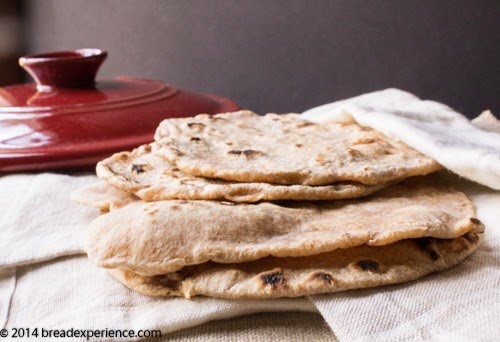
When I learned we would be making these puffy flatbreads, I was a bit skeptical. I thought, “Just hold the bread over a flame and watch it puff up… yeah, right!“ The skeptic in me wanted to know how to do this on a gas stove without getting burned. And, why do they need to puff up? Does this improve the texture or flavor of the bread?
My first attempt at making chapatis was less than optimal. They tasted like fried flour and water. I didn’t think this was what Elizabeth had in mind when she chose this Indian flatbread as the challenge for January for the BBB so I waited a couple of days and tried it again.
Once I got over my initial reaction, I decided to just do it. One evening after work, I made the dough and tried my hand at puffing the flatbreads over the gas flame. I still didn’t quite know what I was doing, but amazingly, some of the chapati puffed up in the pan. They were a bit heavy because I had used too much flour when I rolled them out.
I was a little disheartened, but after seeing photos of the lovely flatbreads the other babes made, I decided to try it again.
This time; however, I did some research on how best to cook them on a gas stove. According to one source, you only have to hold them over the flame if they don’t puff up in the pan. If the surface heat of the pan or griddle is hot enough, they should (or could) puff up automatically in the pan.
Another reason to utilize the “hold-over-the-flame” technique is to speed up the process when you are making a bunch of chapatis. For this approach, you hold one over the flame to puff it up while you are cooking another roti on the griddle. Sounds like an efficient method once you get the hang of it.
This one puffed up in the pan very nicely so I didn’t need to hold it over the flame.
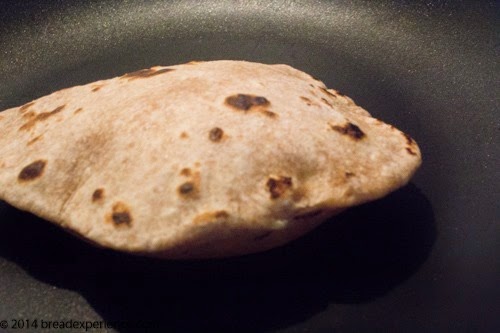
The reason you want to let them puff up is so they will be soft and tender. Ah ha! That’s why my first batch tasted like fried flour and water.
While you are cooking these flatbreads, you aren’t supposed to let them get scorched. If they do start to scorch, you’re supposed to remove them from the pan or flame even if they haven’t puffed up. Some of mine got a little scorched while I was waiting for them to puff, but I didn’t mind the scorched spots. It gave the rounds a slightly charred flavor.
Making Chapati on an electric stove:
Elizabeth’s post http://etherwork.net/blog/bbb-chapatis/ outlines the process for making them on an electric stove.
Click here to watch Elizabeth’s awesome video of making and puffing the rotis on an electric stove: https://www.youtube.com/watch?v=HSZd92w2e6Q#action=share
Elizabeth’s recipe is based on “Flat Wholewheat Bread – Roti” in A Taste of India by Madhur Jaffrey
Making Chapati on a gas stove:
I adapted Elizabeth’s recipe the second time I made these Indian flatbreads. This version includes a 50/50 mixture of whole wheat to all-purpose flour. I also added a little bit of olive oil. The oil is optional but I found it helped to soften the dough. The oil also provides good keeping quality if you want to save some of the flatbreads to eat another day.
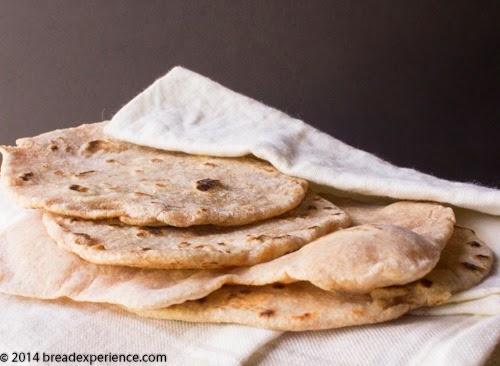
Some helpful resources:
- http://indianfood.about.com/od/breadrecipes/ig/How-to-Make-Chapatis/
- http://sikhism.about.com/od/Atta_Recipes/ss/How-To-Make-Roti-Illustrated-Instructions_12.htm#step-heading
Ingredients:
Makes: 8 chapatis
- 1 cup unbleached all purpose flour
- 1 cup whole wheat flour
- 1 teaspoon salt
- 1 tablespoon olive oil (optional)
- 1 cup just-boiled water
Directions:
In a bowl, mix flours and salt. Add hot water gradually, stirring with a fork until you have a soft dough. The amount of water will vary drastically depending on air temperature and humidity. You just have to play with it. You are aiming for dough that resembles silly putty.
Using as little extra flour as possible, knead on a board or in the air for 10 minutes until the dough is soft and silky.
Put the dough back in the bowl. Cover with a damp cloth or plate and let sit on the counter for 30 minutes to one hour.
Put the pan or griddle on medium heat. Do not oil it.
Cut the dough into 8 equal pieces. Lightly flour each one and put 7 pieces back in the bowl. Cover the bowl. Form the piece of dough into a ball and flatten it. Roll it out into a round until it is quite thin but not too thin. You’ll have to play around with the thickness to find out what works best for you.
As you roll out the dough, make sure it is not sticking to the board and that there are no holes. Keep the rolling pin lightly dusted with as little flour as possible and the board the same way.
Place the round of dough on the hot griddle. As soon as you see little bubbles form, turn it over using tongs. If the pan is hot enough, it should start to puff up. If not, hold it over the gas flame at low heat. Turn it over once or twice to ensure that it puffs up completely. Don’t be worried to see a few dark brown spots on it.
Photos showing rotis puffing up.
As you can see, mine weren’t exactly round. The first didn’t puff up all the way. The four frames at the bottom show one that puffed up all the way. Finally!
Put the finished flatbreads into a pot and cover it with a lid. Keep it in a warm oven. Roll out the next piece of dough and repeat until you have 8 rotis. As you put a new roti on the stack, turn the finished rotis over to keep the bottom ones from getting wet.
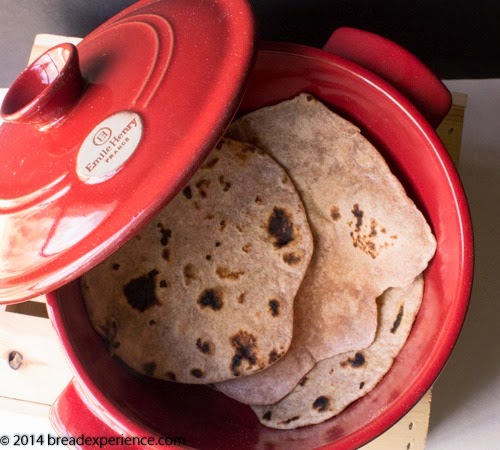
I’m starting to get the hang of the rolling and the puffing. It’s not that hard, but it does take a little practice. I’ve been enjoying these chapatis with lentil soup. They also make a great snack!
Thanks, Elizabeth! This was a great challenge to get me out of my bread box.
Bread Baking Babes (current dozen):
- Bake My Day – Karen
- blog from OUR kitchen – Elizabeth
- Bread Experience – Cathy
- Feeding my Enthusiasms – Pat/Elle
- girlichef – Heather
- Life’s a Feast – Jamie
- My Diverse Kitchen – Aparna
- My Kitchen In Half Cups – Tanna
- Notitie Van Lien – Lien
- Thyme for Cooking – Katie (Bitchin’ Bread Baking Babe Bibliothécaire)
If you would like to bake along with us and get a Buddy Badge:
Just make the Chapati (Roti), then email your link to Elizabeth, the kitchen of the month, or post your photo to the BBB FB page. Refer to her post for details.
Once you’ve posted, you’ll receive a Buddy badge for baking along, then watch for a roundup of all of the BBBuddies posts a few days after the close of submissions.
I hope you’ll join us this month!
Happy Baking!
Cathy
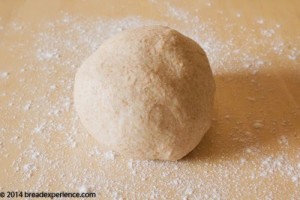
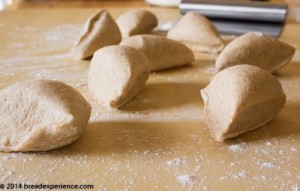
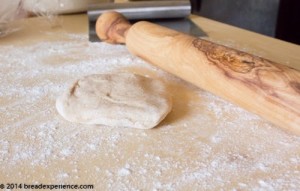
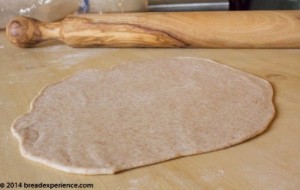
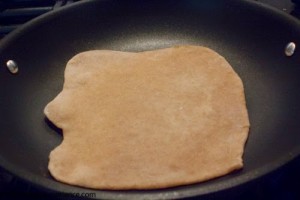
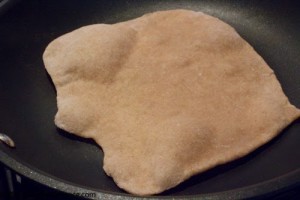
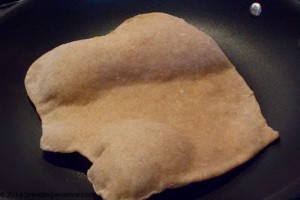
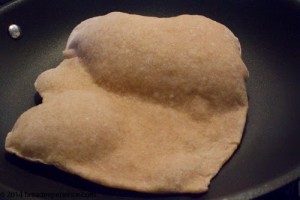
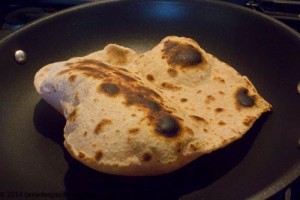
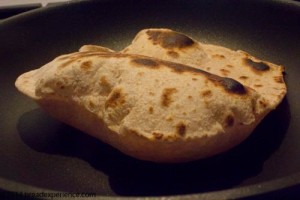
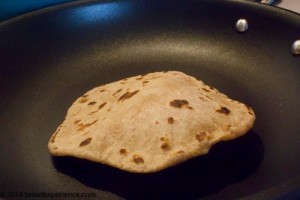
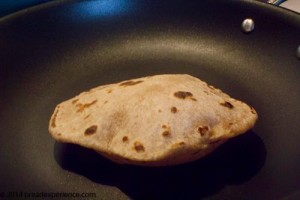
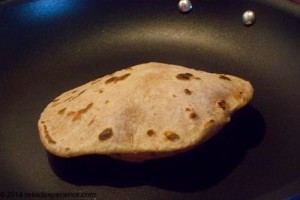
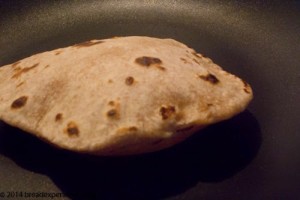
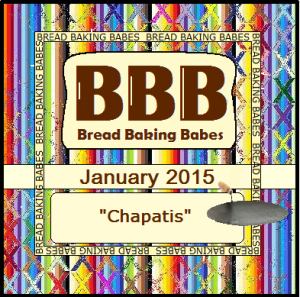
Heather Schmitt-Gonzalez says
Now that is some fantastic puffing – I’m glad you decided to give it another go! I love the thickness of yours, too. I feel like I had less dough than I’m seeing with everybody else. Strange….
Cathy W. says
Thanks Heather! It was worth the effort.
Elizabeth says
I’m so glad you persevered, Cathy! And your chapatis look perfect.
It’s so thrilling when they puff, isn’t it? (Lucky you, that they puffed on the pan!)
Cathy W. says
Thank Elizabeth! It is thrilling when they puff. Thanks for the challenge!
Katie Zeller says
I can almost see my frustration at trying to get them to puff. You persevered and they look lovely.
Cathy W. says
Thanks Katie! I’m starting to get the hang of it.
MyKitchenInHalfCups says
Perseverance wins the day again. Obviously it paid off in spades, they look great.
I’m thinking these could be just wonderful with all whole wheat and I think I’ll have to try that.
Cathy W. says
Thanks Tanna! I almost made all whole wheat myself.. I’m going to try that next as well.